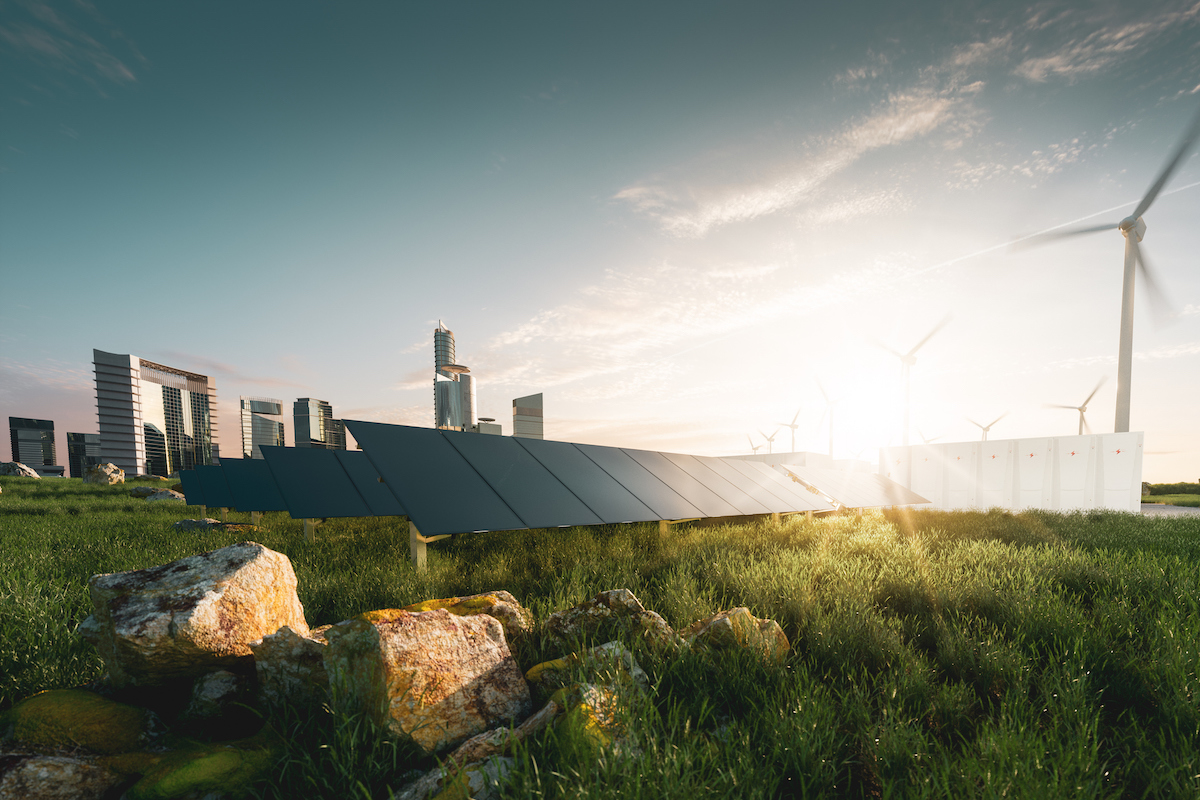Today, the city of Los Angeles and the National Renewable Energy Laboratory (NREL), with strong community and stakeholder support, released their long-awaited study that shows how the nation’s largest public utility, the LA Department of Water and Power (DWP), will build an affordable and reliable electric system powered entirely with clean, renewable energy.
What LA is proposing is transformative, and it provides a roadmap for how the nation can transition away from fossil fuels in a way that aligns with the hard realities of carbon budgets and the brief timeline we have to avert the worst impacts of the climate crisis. President Biden campaigned on 100 percent clean energy by 2035, and today LA has laid out a pathway to get there. LA’s announcement is best viewed as a pilot for the nation -- how one major utility, a microcosm of the US grid as a whole, is decarbonizing at the pace and scale required to respond to the climate crisis.
Los Angeles Has Come a Long Way
A decade ago, Los Angeles and the US had remarkably similar energy portfolios, both heavily reliant on polluting coal and gas.
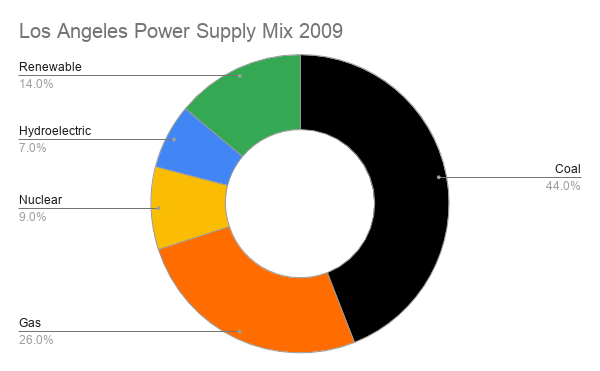
Data from LADWP.
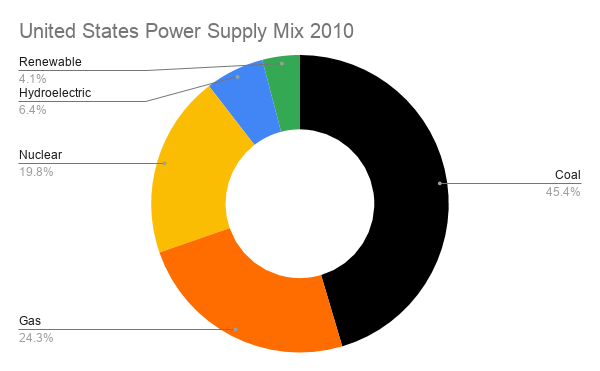
Data from EIA.
Back then, just one of 15 city councilmembers supported phasing out coal by 2020, the City Council had gutted LA’s energy efficiency program, and the business community was in the process of killing a proposal from the utility to comply with the state’s Renewable Portfolio Standard (RPS).
Since that time, sustained organizing, coalition building, and emergent leadership in City Hall have realigned the politics of LA in support of a fossil-free future. Campaigns like the Los Angeles Alliance for a New Economy’s RePower LA initiative quadrupled investments in energy efficiency, redesigned programs to focus on low-income communities, and expanded union jobs in efficiency. The Los Angeles Business Council built out the nation’s largest feed-in tariff program, bringing together organizations like Communities for a Better Environment, property managers, and local solar companies to build out hundreds of megawatts (MWs) of rooftop solar, while the Sierra Club, Earthjustice, and other environmental organizations organized to phase out coal and gas. LA's transition from coal has also involved buying power from solar facilities on lands belonging to Tribes such as the Moapa Band of Paiutes.Talks are ongoing to do the same with the Navajo Nation -- once home to the massive coal-fired Navajo Generating Station that helped power LA for decades.
Today’s initiative, known as LA100, began in 2016 when City Council members Krekorian and Bonin co-led a motion to direct DWP to determine the necessary investments to achieve a 100 percent renewable energy future. Over the last five years, LA100 has incorporated various policy decisions DWP has made under the leadership of Mayor Garcetti and the City Council, such as setting ambitious and achievable electrification goals for our buildings and transportation sector, and retiring the gas plants in the LA Basin.
Los Angeles Is Set to Build a Lot of Clean Energy, Very Quickly
In stark contrast to the California Public Utilities Commision, which is poised to double down on fossil fuels, DWP is gearing up to build thousands of megawatts of new clean energy resources, upgrading its transmission and distribution systems, and bringing substantial public health and economic benefits to the region. While the LA100 plan lays out several different pathways to a 100 percent renewable energy future, the utility’s immediate steps are a series of “no regrets” investments that would be made in any of the scenarios and accelerate our transition away from fossil fuels while creating much-needed secure jobs that pay family-sustaining wages. So what are those investments?
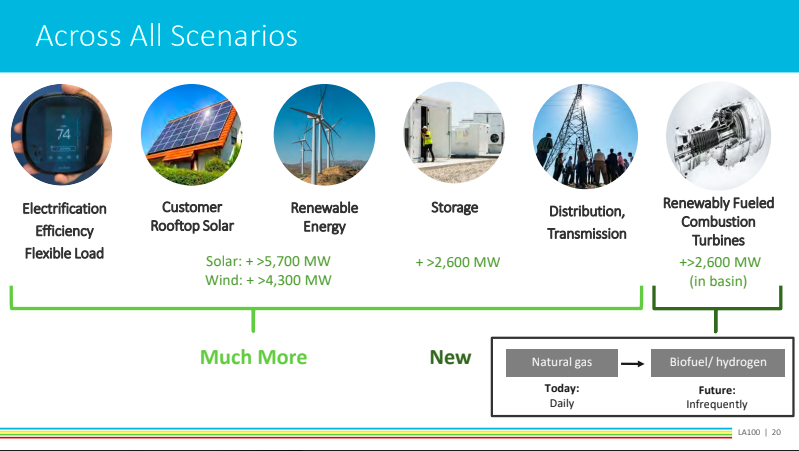
“Much more” is right. In total, the “no regrets” strategy amounts to more than 12,000 MWs of new clean energy across wind, solar, and battery storage, with minimal investments in green hydrogen to be used in times of grid stress. Mind you, DWP averages about 5,000 MWs of demand and peaks just under 7,000 MWs during extreme climate heatwaves. You can see below that, overall, a 100 percent renewable energy future will require DWP to double its existing energy portfolio within the next 15 to 25 years.
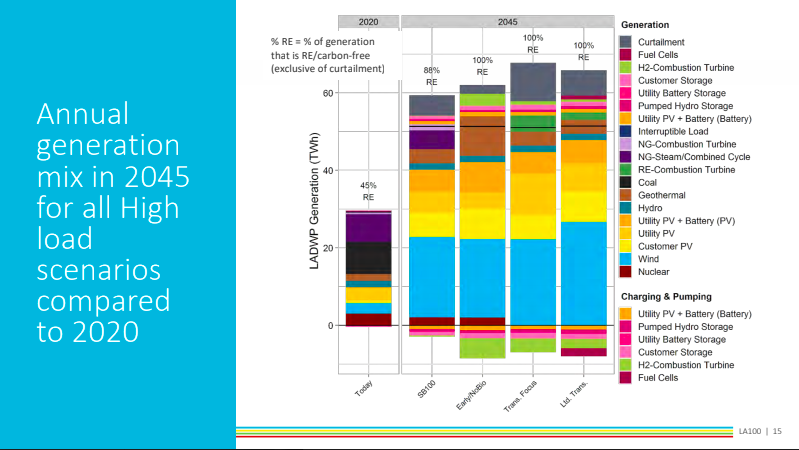
Looking into the details, the LA100 study shows how the scenarios differ in terms of investments and what is and isn’t included within a 100 percent renewable grid. In some scenarios, DWP relies on biofuels or even continues gas generation through the use of renewable energy credits. Only one scenario allows DWP to complete the transition to a 100 percent renewable gridby 2035, a target date that aligns with President Biden’s 100 percent clean energy commitment and proves that it is doable.
With climate change reshaping our communities, LA’s only viable option to meet the moment is to follow that pathway, which achieves 100 percent renewable energy by 2035, avoids biofuels, retires gas, and cuts 98 percent of its greenhouse gas emissions by 2030.
Without question, the unprecedented amount of investment and the retirement of local in-basin power plants is going to be hard, especially in a transmission-constrained region like the LA basin. But we know it's possible, as Mayor Garcetti, the City Council, and DWP have never shied away from a challenge. In little more than a decade, LA has moved beyond coal, has become the number one city for solar in the country, and will now transition away from gas. Our city representatives well know what it means to be leaders.
Today’s announcement is the culmination of years of work by a diverse set of organizations -- progress like this takes nothing less than a village. We applaud and celebrate LA’s leadership in achieving this critical, first-in-the-nation milestone; tomorrow, we will shift to working with our members and other stakeholders on implementing the LA100 roadmap through DWP’s long-term planning process. Our priority will be not only getting to 100 percent renewable energy as quickly as possible but also making sure that LA’s investments will create a healthier and more liveable future for Angelenos, especially those on the frontlines of fossil fuel infrastructure. We can achieve this through reduced air pollution, the creation of good-paying union jobs, and a power grid that can enhance resiliency during extreme weather events for vulnerable communities that cannot afford to go without power.
The rest of California, the country, and the world should take note. As Mayor Garcetti put it in his recent testimony to Congress: “An energy grid that is 100 percent renewable, reliable, and resilient can be achieved.” It’s time to move past the excuses for why we need fossil fuels, and move toward the clean energy future that we all know is within our reach.
